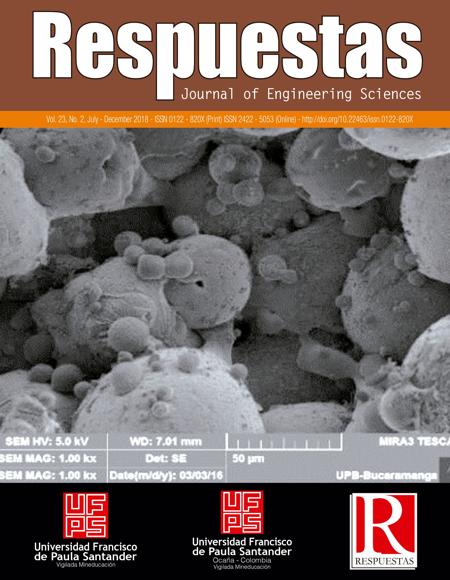Methodology for evaluating linear and non-linear effects in a radio over fiber system
Metodología para evaluar los efectos lineales y no lineales en un sistema de radio sobre fibra óptica
Main Article Content
This article shows the methodology used to evaluate the linear and non-linear effects present in a radio over fiber system (RoF) by employing the multiplexing technique used for dense wave division, the Dense Wavelength Division Multiplexing (DWDM) technique. It is completed with a dissemination of 50 GHz, in accordance to the standards of the International Telecommunication Union (ITU), through a channel speed of 10 Gbps, at an input power in the optical channel of 30mW, for optical fiber stretches of 40km, 60km and 80km. It presents the modeling of the RoF system graphically through a block diagram by means Matlab, a computational tool, whereby each of the stages of the RoF system are implemented using the libraries offered by the ‘simulink’ toolbox of Matlab. As a result, it is obtained that the methodology proposed for the evaluation of the RoF system using the DWDM technique allows for the analysis of linear and non-linear effects; where it is observed that the effects that degrade the signal are proportional to the established distances of the optical fiber and that the optical input power used is optimal for the optical fiber to behave as a non-linear medium.
Downloads
Article Details
C. Hernández, G. Enrique, S. Alfaro y G. Paola, “Software de simulación de diferentes tipos de modulación de señales de radiofrecuencia sobre fibra óptica”, Umbral Científico, nº 9, pp. 76-84, 2006.
A. Liu, H. Yin, B. Wu. High-efficient full-duplex WDM-RoF system with sub- central station. Optics Communications. 2018. 414, 72-76. https://doi.org/10.1016/j.optcom.2017.12.068
T. Yang, M. Gao, J. Qian, Y. Zou, L. Xiang, G. Shen. A novel radio-over-fiber system with dual millimeter-wavesignals generated simultaneously. School of Electronics and Information Engineering, Soochow University. 2016. http://dx.doi.org/10.1016/j.ijleo.2016.04.068
J. Álvarez, F. Amaya. Impacto de los efectos lineales y no lineales en el requerimiento del ancho de línea del transmisor en sistemas WDM-DPSK. Rev. UIS Ingenierías, 2015, vol. 14, no 2, p.p. 35-45.
A. Torres, K. C. Puerto, D. Guevara, “Efectos lineales presentes en un sistema de radio sobre fibra óptica empleando multiplexación por división en longitud de onda”, ETCM 2016, Guayaquil , Ecuador, 2016.
N. Masabanda, N. Marmol, “Análisis y Simulación de un Enlace de Radio sobre Fibra Óptica (ROF) a 60 GHz”. Disponible en: http://dspace.ups.edu.ec/bitstream/123456789/5356/1/UPS-ST001033.pdf. [Último acceso: 07 03 2018].
F. Ramos. “Estudio de efectos no lineales en dispositivos fotónicos y su aplicación en sistemas de radio sobre fibra”. Tesis Doctoral, Universidad Politécnica de Valencia, Abril 6 del 2009.
J. Pérez. “Coexistencia e Integración de Comunicaciones Inalámbricas en Sistemas de Transmisión Ópticos”. Universidad Politécnica de Valencia, Departamento de Comunicaciones. Julio del 2009, pp 1- 193.
Unión Internacional de Telecomunicaciones [online]. Disponible en: https://www.itu.int/itu-/recommendations/rec.aspx?rec=10868
Francisco R. Pascual, “Estudio de los Efectos no lineales en dispositivos Fotonicos y su aplicación en sistemas de radio sobre fibra óptica”.
M. L. Calvo “Dispersion Cromática” disponible.http://webs.ucm.es/info/giboucm/Download/chromatic_dispersion.pdf
F. Gómez, L. A. Garcia, K. C. Puerto, D. Guevara “Modelado De Los Fenómenos No Lineales Generados Por El Efecto Electro-Óptico Kerr En Una Transmisión Por Fibra Óptica”, Rev. Colombiana de Tecnologías de Avanzada, vol. 2, no. 28, pp. 82-87, 2016
Mathworks.com [online]. Disponible en: https://la.mathworks.com/products/simulink.html
Unión Internacional de Telecomunicaciones. Norma G.652 [online]. Disponible en: https://www.itu.int/rec/T-REC-G.652/es
F. Marangione. Modelo Simulink para redes de comunicaciones ópticas multiservicio. 2007. Valencia, España.
A. Torres, K. C. Puerto, D. Guevara, “Efectos lineales presentes en un sistema de radio sobre fibra óptica empleando multiplexación por división en longitud de onda”, ETCM 2016, Guayaquil , Ecuador, 2016.
G. Campuzano “Telecomnicaciones Radio Sobre Fibra” disponible [En Linea]. http://www.mty.itesm.mx/die/ddre/transferencia/67/67-III.03.html. [Último acceso: 7 Junio 2017].
G. P. Agrawal, “Fiber-Optic Communication Systems”. 4 a ed. New York, USA: John Wiley & Sons. 2002.
K. C. Puerto, B. Medina, L.L. Camargo “Efecto De La Dispersión Cromática En Un Sistema Híbrido”, Rev. Colombiana de Tecnologías de Avanzada, vol. 2, no. 24, pp. 51-58, 2014.
L. A. Garcia, K. C. Puerto, D. Guevara, “Efectos de la Modulación de Fase Cruzada en comunicaciones por fibra óptica”, VII BETCON, 2015, La Paz, Bolivia, 2015.
A. Stöhr, A. Akrout, R. Buß, B. Charbonnier, F. van Dijk, A. Enard, S. Fedderwitz, D. Jäger, M. Huchard, F. Lecoche, J. Marti, R. Sambaraju, A. Steffan, A. Umbach, M. Weiß. 60 GHz radio-over-fiber technologies for broadband wireless services. Optical Society of America, Journal Of Optical Networking. May 2009, Vol. 8, No. 5 pp 471 – 487.







